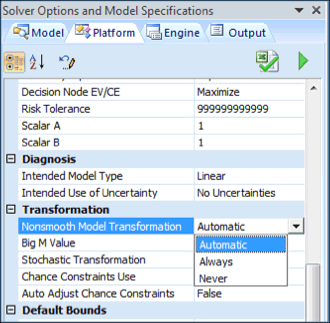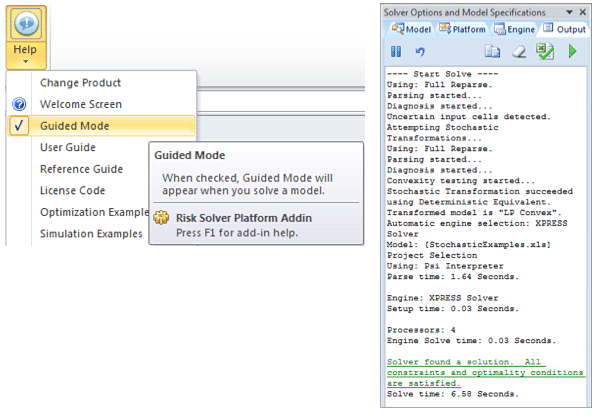Automatic, Guided, Auto-Help, and Interactive Modes Overview
Many of our products include special ease-of-use modes designed to help you get the most out of our Solvers - and the best answers.
- Automatic Mode allows Frontline Solvers to diagnose model type and attempt to transform it to make it easier to solve or get a better answer. In addition, it helps remove the guesswork about which methods and engine to use by automatically choosing the best available method and engine for your particular model.
- Guided Mode is like having an expert at your side to help you understand your model, how to correct any errors found, how you might be able to make it even better (more scalable, structured for a better answer, etc.) and how to think about the answer found (global vs. local optimal solution, etc.).
- Auto-Help Mode is silent when all's well, but brings up Guided Mode dialogs whenever you encounter an error condition while solving. When you're fully up to speed, use this mode for help whenever you need it.
- Interactive Mode for Simulation allows you to conduct real time what-if analysis taking advantage of the speed of our Monte Carlo Simulation engine to do virtually instant simulation runs anytime a cell is changed in the worksheet. All output cells and charts are instantly updated to give you instant insight.
All four are only available in Frontline Solvers, thanks to the proven and proprietary PSI Interpreter. All three modes are easily to turn on and off, giving you total control of your model, methods, and solution. The table below summarizes our products' modes and their capabilities.
|
|
Premium Solver Pro |
Risk Solver Pro |
Premium Solver Platform |
Risk Solver Platform |
|
Automatic Mode |
|
|||
| Model Diagnosis | Yes | Yes | Yes | |
| Model Transformation | Yes | Yes | ||
| Automatic Engine Selection | Yes | Yes | Yes | |
|
Guided Mode |
Yes |
Yes |
Yes |
|
| Auto-Help Mode | Yes | Yes | Yes | |
|
Interactive Simulation Mode |
Yes |
Yes |
Automatic Mode
Automatic Model Diagnosis
Automatic Mode’s first benefit is automatic diagnosis of the type of model defined by the user's Excel worksheet. Optimization models can range from linear and convex problems that are easy to solve, and easy to "scale up" to large size (hundreds of thousands of decision variables or more), to non-convex and non-smooth problems that are intrinsically very difficult to solve ("NP-hard"). These cannot be "scaled up" beyond a few hundred variables. Since any kind of model can be created easily in Excel, users who don't know the difference can sabotage their own efforts by using Excel functions such as IF and LOOKUP that make an otherwise "easy" model very hard to solve, causing solution times to go from seconds to hours.
To diagnose, Automatic Mode analyzes the user's Excel formulas and dependencies among them, and explains the type of problem the user has defined: LP (linear programming, the easiest), QP, QCP, SOCP, NLP (nonlinear programming), or NSP (non-smooth programming, the most difficult), and its use of other features which strongly impact solvability. For optimization models with uncertainty, Automatic Mode determines whether the user has defined a stochastic linear programming (LP) or stochastic QP model, and whether the model includes decision-dependent uncertainties, chance constraints, and recourse decision variables, which strongly impact the solution process. Although Risk Solver Platform can handle all of these model types, the difference in solution time can be huge -- a factor of 1,000 times or more.
Automatic Model Transformation
For non-smooth models that are very difficult to solve due to Excel functions such as IF, AND, OR, NOT, MIN or MAX, and VLOOKUP or HLOOKUP, Automatic Mode will automatically attempt to transform the model into a form that is much more practical to solve. It does this by adding new integer and real-valued decision variables and linear constraints to the model, which enforce the same conditions as these Excel functions, thus replacing the non-smooth, non-convex Excel functions. When this transformation is successful, the more easily solved result (such as a linear mixed-integer (LP/MIP) model) allows for very fast and advanced solution methods to be applied.
For optimization models with uncertainty, Automatic Mode will automatically attempt to transform stochastic LP and QP models into equivalent conventional optimization models that can be solved quickly and scaled up to large size - without using the much slower method of simulation optimization. This includes the ability to automatically create robust counterpart models, a powerful facility introduced by Frontline in late 2007 that still has not been matched by other commercial products. For models that cannot be so transformed, Risk Solver Platform offers the industry's fastest, fully parallelized simulation optimization methods, using the latest improvements in Frontline's nonlinear Solvers and its hybrid Evolutionary Solver.
To turn Nonsmooth Model Transformation on or off, simply go to the Transformation section of the Platform tab and set Nonsmooth Model Transformation to Automatic, Always, or Never.
• “Automatic” will attempt a transformation (if the model is diagnosed as potentially transformable), evaluate the result against the original, and set the superior version to be used.
• “Always” will attempt the same transformation as in “Automatic” but will force the use of the transformed model.
• “Never” will result in no attempt being made to transform the model.

Automatic Solver Engine Selection
Premium Solver Pro offers three Solver Engines. Premium Solver Platform and Risk Solver Platform include five for optimization, and can accept any of eight more as plug-in Solver Engines. Each Solver Engine is best-suited for certain types and sizes of models. Although they can be used for other types of models, some should not be used in some cases. Automatic Mode can automatically select the best Solver Engine for the type and size of model that the user has defined, from the set of Solver Engines currently installed. It can also warn the user when he or she manually selects a Solver Engine that should not be used for the current model.
You can turn Automatically Select Engine on or off by checking the related box on the Engine tab in the Task Pane.

Guided Mode
Guided Mode helps bring all the “behind the scenes” work done by Premium Solver Pro, Premium Solver Platform, and Risk Solver Platform to the forefront. It acts like an expert sitting next to you, educating you on what is going on, and providing useful insight. Guided Mode shows:
- Any errors discovered, and gives insight on what you may be able to do to fix them.
- How the structure of your model is impacting the quality and speed of the answer you will get, and how you can make you model more scalable.
- Which type of answer was found, such as a local or global solution.
Guided Mode does "pause” the solve process to show you what it is learning and doing, which can slow things down. But when you're up to speed, simply switch to Auto-Help Mode. In this mode, you run at full speed unless there's a problem. Even in Expert Mode (the third choice), by looking at the Output Tab of the Task Pane, you can see summary information on model type, whether a transformation took place, and the solution.

Interactive Simulation Mode
With Interactive Simulation turned on in Risk Solver Pro and Risk Solver Platform, risk analysis for uncertain models becomes as easy as asking 'what if'. Each time you change a number on the spreadsheet, a simulation with thousands of trials is performed -- often in no more time than a single spreadsheet recalculation -- and a full range of simulation results and statistics can be displayed. Suddenly, you find that insights about the model, and decisions you can make, start to flow intuitively.
But there is a deeper advantage of Interactive Simulation: It gives you a new way to think about your model. The key step in risk analysis -- versus conventional spreadsheet 'what-if' analysis -- is to think in terms of a range of scenarios, considered at once. With Interactive Simulation, you can begin to think of each worksheet cell as representing not just a single number, but an array of numbers that covers the full range of possibilities.
Interactive Simulation could be part of any Monte Carlo Simulation engine - if they were fast enough. Risk Solver Pro and Risk Solver Platform have that capability. You create an ordinary 'what-if' spreadsheet model, with cells and formulas to compute the results you need, for just one scenario. Risk Solver does the rest -- computing Monte Carlo trials up to 100 times faster than using Excel alone. Psi Technology makes Interactive Simulation practical for realistic simulation models.
To turn Interactive Simulation on or off, in the Risk Solver Pro or Risk Solver Platform Ribbon in Excel click on the Simulate light bulb in the Solve Action group. When the light bulb is lit, interactive simulation is on.
Register to download a free trial now ➡
